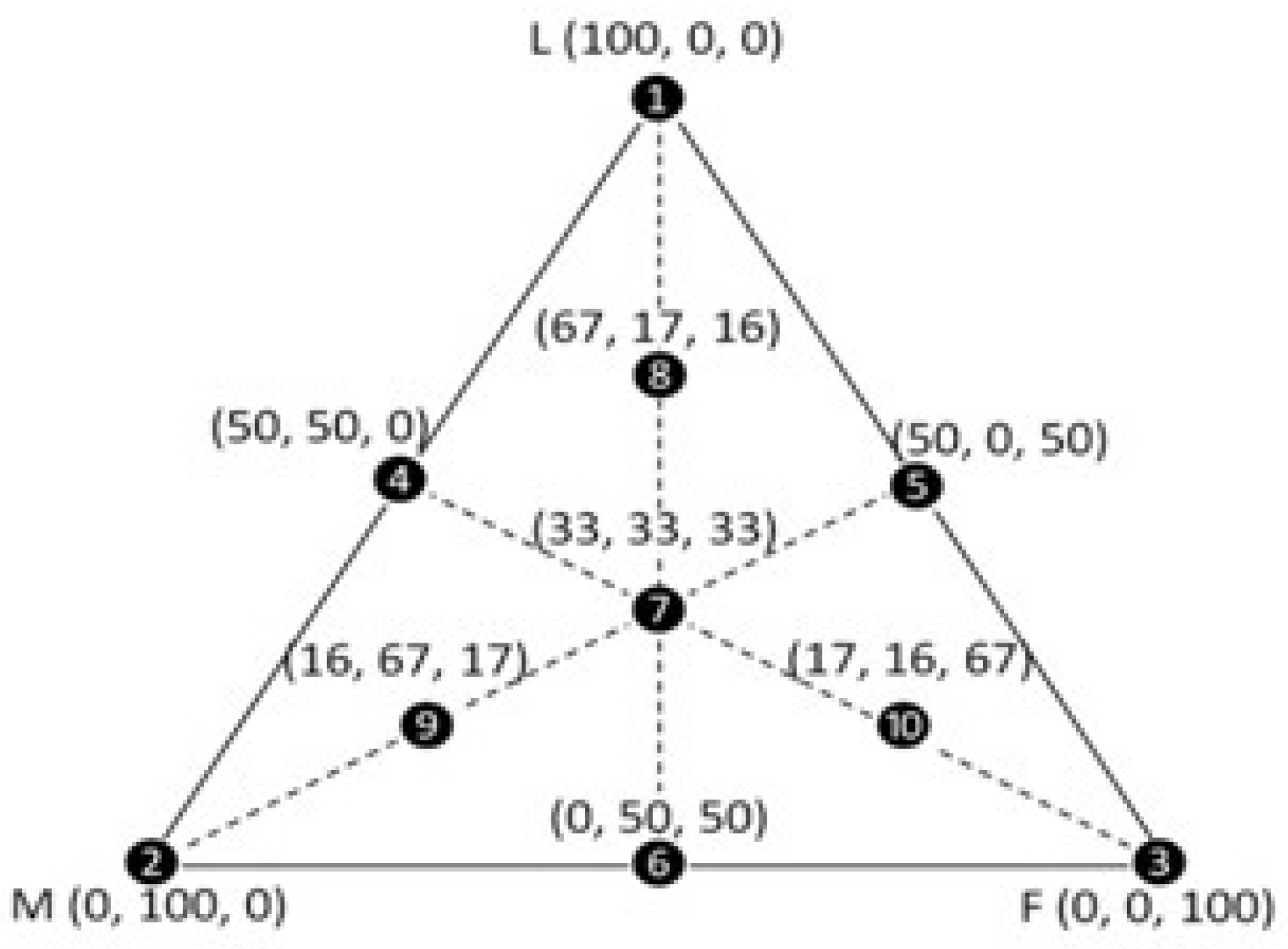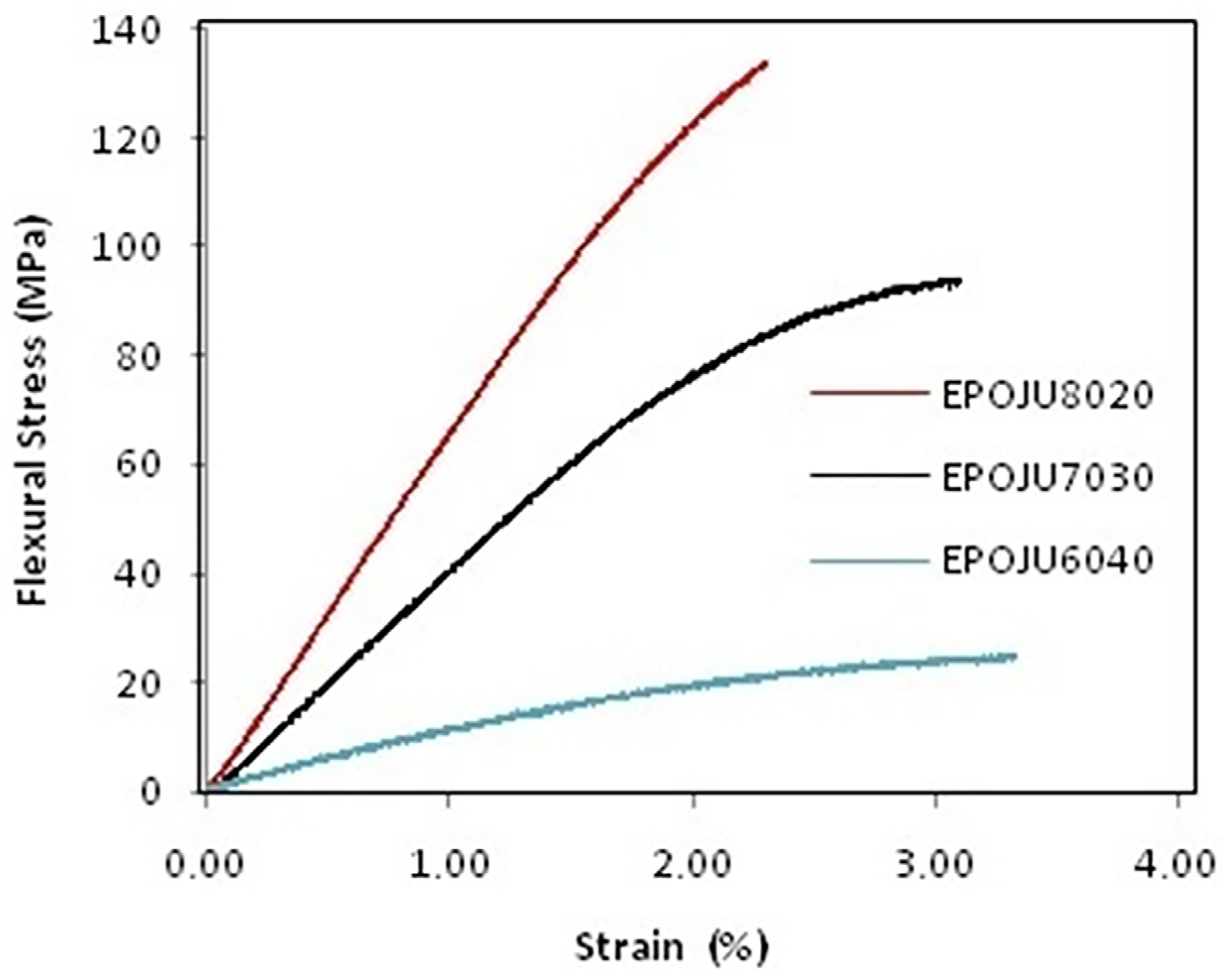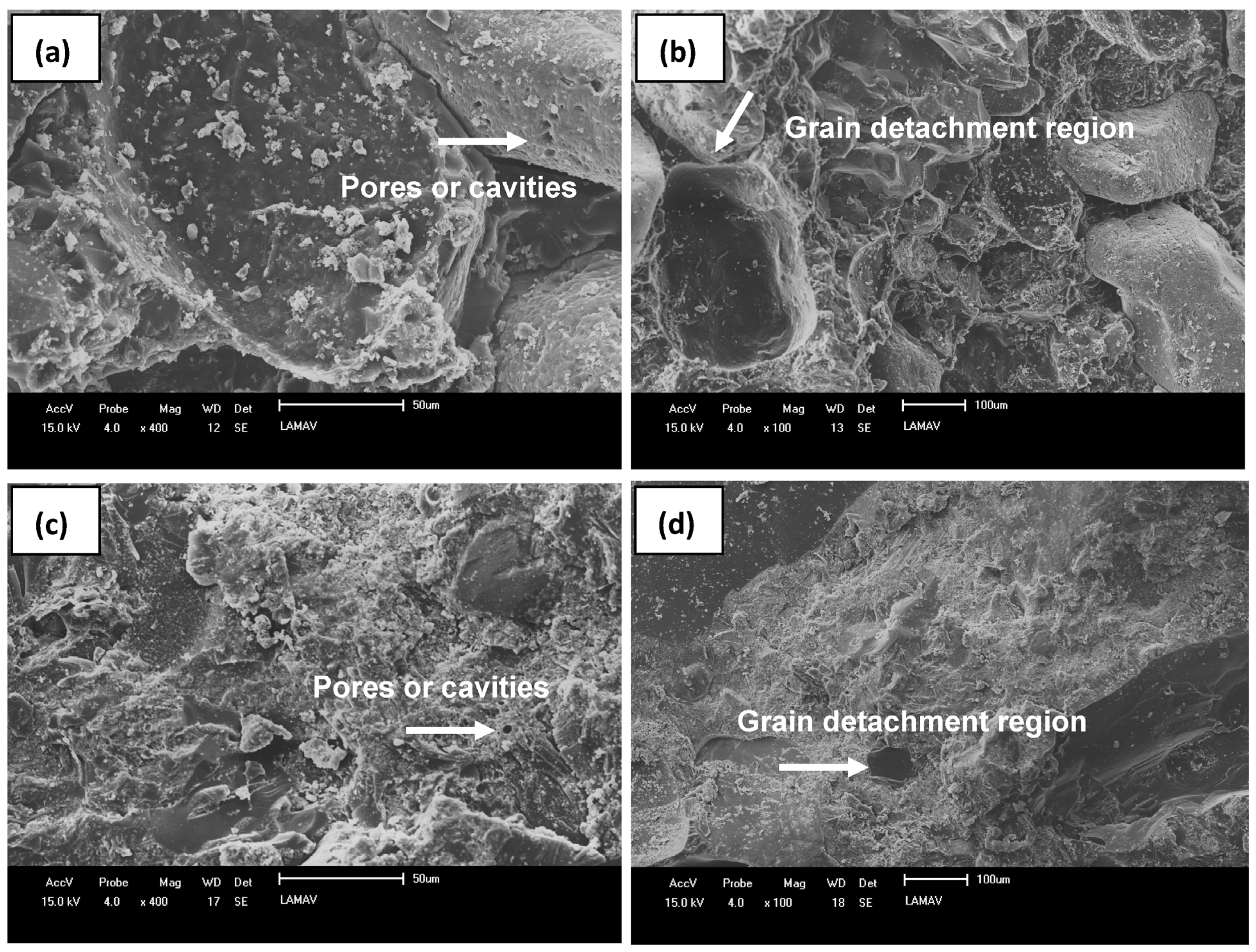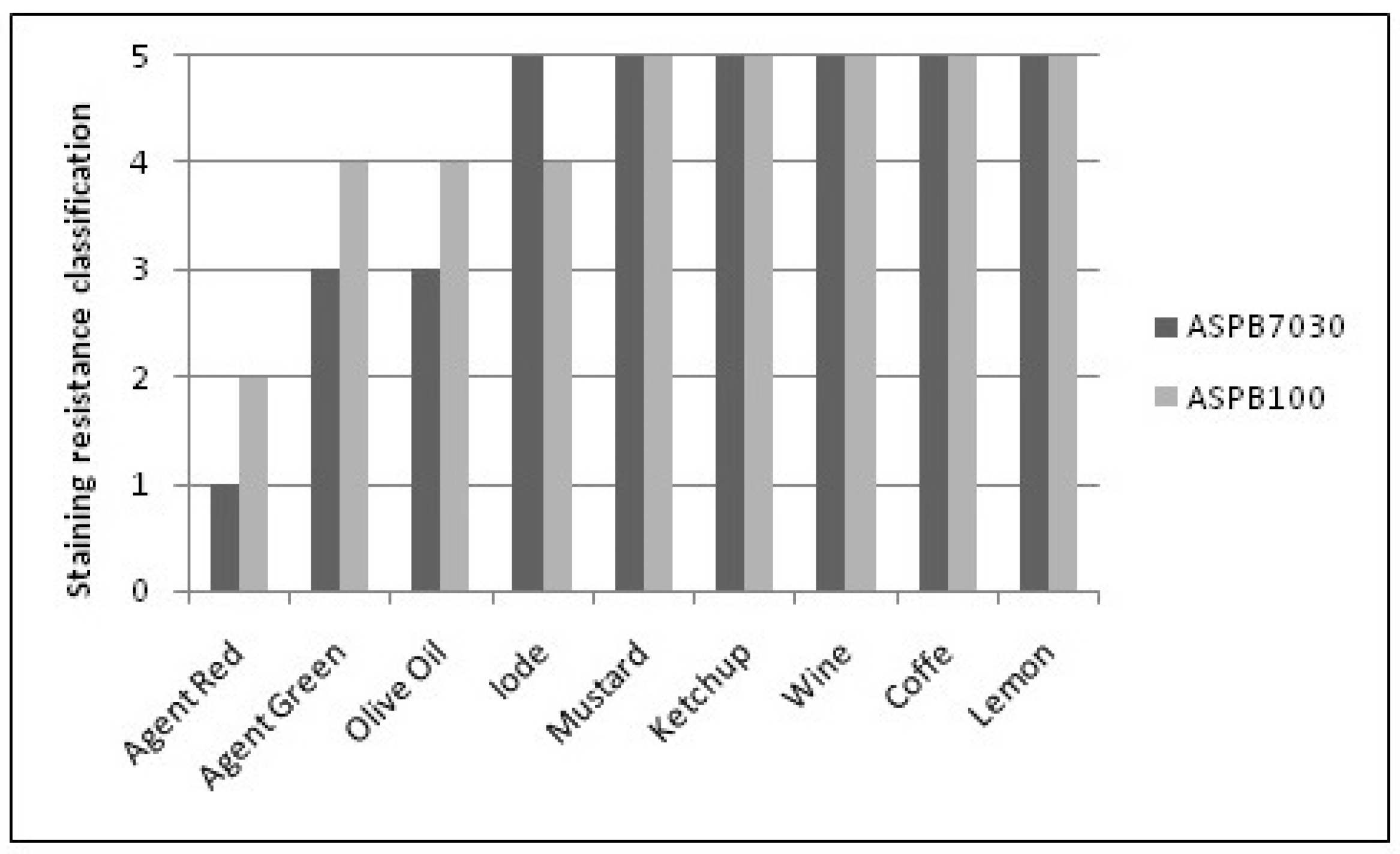Characterization of Artificial Stone Produced with Blast Furnace Dust Waste Incorporated into a Mixture of Epoxy Resin and Cashew Nut Shell Oil
Abstract
1. Introduction
2. Materials and Methods
2.1. Materials’ Characterization
2.2. Determination of the Highest Packaging Granulometric Composition

2.3. Production of Artificial Stones
2.4. Characterization of Artificial Stone Plates
3. Results
3.1. Materials’ Characterization
3.2. Determination of the Highest Packing Density
3.3. Physical Properties
3.4. Mechanical Properties
3.5. Chemical Properties
4. Conclusions
- An innovative artificial stone was developed, using quartz and blast furnace dust waste, demonstrating the efficiency of the incorporation of this waste in the artificial stone’s development. Two binders, pure epoxy (ASPB100) and a mixture of 70 wt% epoxy and 30 wt% cashew nut shell oil (CNLS) (ASPB7030), were used.
- Based on the ternary diagram developed in the experimental numerical modeling grid simplex, the composition that displayed the highest vibrated density, and thus the highest packing, was chosen to produce the stones. These data were authenticated using ANOVA and the Tukey test.
- Both artificial stones presented satisfactory physical indices, with ASPB100 presenting lower porosity and water absorption, making it possible to be applied in humid environments such as kitchens and bathrooms.
- ASPB7030 and ASPB100 displayed 31.0 ± 2.5 MPa and 25.0 ±1.5 MPa mechanical strength in three-point bending, thus classifying them as stones of very high strength (suitable to be applied as coating) and corroborating the porosity results.
- Amsler wear tests indicated that ASPB100 with 0.84 mm ± 0.01 thickness reduction can be applied in floors of high traffic areas, while ASPB7030 with 2.09 mm ± 0.27 thickness reduction can be used for medium traffic ones.
- SEM micrographs proved the physical index and mechanical property results, displaying the optimal load–matrix interaction for both developed stones. ASPB7030 had particles detached from the fractured region, which could be associated with its lower content of epoxy resin. As such, the agglutination of particles in ASPB7030 was not as efficient as in ASPB100.
- The resistance to staining indicated that both stones are not easily stained, except for the red staining agent, which remained in ASPB7030 even after all cleaning steps.
- Both artificial stones produced are an economically viable and sustainable alternatives. ASPB7030 stands out for having two wastes (CNSL and blast furnace dust waste) that do not need any prior treatment, which would mean a cost saving. Both demonstrate excellent physical and mechanical properties for civil construction applications.
Author Contributions
Funding
Institutional Review Board Statement
Informed Consent Statement
Data Availability Statement
Acknowledgments
Conflicts of Interest
References
- Suta, S.; Wattanasiriwech, S.; Wattanasiriwech, D.; Duangphet, S.; Thanomsilp, C. Preparation of engineered stones. Mater. Sci. Eng. 2019, 600, 012009. [Google Scholar] [CrossRef]
- Bagherpor, Z.; Nazari, S.; Bagherzadeh, P.; Fazlavi, A. Description and efective parameters determination of the production process of fne-grained artifcial stone from waste silica. SN Appl. Sci. 2019, 10, 1458–1468. [Google Scholar] [CrossRef]
- Souza, E.F.; Morais, C.R.S. Caracterização física e mecânica de rocha artificial com resíduo de pó de vidro sódico-cálcico e resina poliéster insaturada por meio de moldagem por prensagem. Rev. Eletrônica Mater. Process. 2018, 13, 190–195. (In Portuguese) [Google Scholar]
- Santos, G.G.; Crovace, M.C.; Zanotto, E.D. New engineered stones: Development and characterization of mineral-glass composites. Compos. Part B Eng. 2019, 167, 556–565. [Google Scholar] [CrossRef]
- Brazilian Association of Ornamental Stone Industry (ABIROCHAS). Annual Balance of Brazilian Exportation and Importation of Ornamentalstonesin2022. Informe01, 2022. Brasília: ABIROCHAS; 2022. Available online: https://abirochas.com.br/wp-content/uploads/2022/05/Informe_02_2022_Exportacoes_1_Trimestre.pdf (accessed on 15 June 2022). (In Portuguese).
- Lee, M.Y.; Chun, H.K.; Chang, F.C.; Lo, S.L.; Lin, J.D.; Shan, M.Y.; Lee, J.C. Artificial stone slab production using waste glass, stone fragments and vacuum vibratory compaction. Cem. Concrets Compos. 2008, 30, 583–587. [Google Scholar] [CrossRef]
- Peixoto, J.; Santos, C.E.A.; Menezes, G.M.L.P.; Silva, G.R.; Monteiro, S.N.; Azevedo, A.R.G.; Vieira, C.M. Incorporation of Industrial Glass Waste into Polymeric Resin to Develop Artificial Stones for Civil Construction. Arab. J. Sci. Eng. 2022, 47, 4313–4322. [Google Scholar] [CrossRef]
- Sarami, N.; Madavian, L. Comparison of Artificial Stone Made from Sludge Stone with Travertine Stone Waste of Stone Cutting Factory. Int. J. Eng. Res. Afr. 2016, 23, 64–71. [Google Scholar] [CrossRef]
- Agrizzi, C.P.; Carvalho, E.A.S.; Gadioli, M.C.B.; Barreto, G.N.S.; Afonso, A.R.G.; Monteiro, S.N.; Vieira, C.M.F. Comparison between Synthetic and Biodegradable Polymer Matrices on the Development of Quartzite Waste-Based Artificial Stone. Sustainability 2022, 14, 6388. [Google Scholar] [CrossRef]
- Silva, F.; Ribeiro, C.E.; Rodríguez, R. Physical and Mechanical Characterization of Artificial Stone with Marble Calcite Waste and Epoxy Resin. Mater. Res. 2018, 21, 1–6. [Google Scholar] [CrossRef]
- Carvalho, E.A.S.; Marques, V.R.; Rodriguez, S.R.; Ribeiro, C.E.G.; Monteiro, S.N.; Vieira, C.M.F. Development of Epoxy Matrix Artificial Stone Incorporated with Sintering Residue from Steelmaking Industry. Mater. Res. 2015, 2, 235–239. [Google Scholar] [CrossRef]
- Anastasios, C.P.; Souliotis, M. End-Of-Use Fly Ash as an Effective Reinforcing Filler in Green Polymer Composites. Polymers 2023, 15, 3418. [Google Scholar] [CrossRef]
- Dermartini, T.; Rodríguez, S.; Silva, F. Physical and mechanical evaluation of artificial marble produced with dolomitic marble residue processed by diamond-plated bladed gang-saws. J. Mater. Res. Technol. 2018, 350, 308–313. [Google Scholar] [CrossRef]
- Peng, L.; Qin, S. Mechanical behaviour and microstructure of an artificial stone slab prepared using a SiO2 waste crucible and quartz sand. Constr. Build. Mater. 2018, 171, 273–280. [Google Scholar] [CrossRef]
- Zarzuela, R.; Gil, M.L.A.; Carretero, J.; Carbú, M.; Cantoral, J.M.; Mosquera, J.M. Development of a novel engineered stone containing a CuO/SiO2 nanocomposite matrix with biocidal properties. Constr. Build. Mater. 2021, 303, 124459. [Google Scholar] [CrossRef]
- Rajawat, A.S.; Singh, S.; Gangil, B.; Ranakoti, L.; Sharma, S.; Asyraf, M.M.R.; Razman, M. Effect of Marble Dust on the Mechanical, Morphological, and Wear Performance of Basalt Fibre-Reinforced Epoxy Composites for Structural Applications. Polymers 2022, 14, 1325. [Google Scholar] [CrossRef] [PubMed]
- Mostovoi, A.S.; Kurbatova, E.A. Controlling the Properties of Epoxy Composites Filled with Brick Dust. Russ. J. Appl. Chem. 2017, 90, 246–256. [Google Scholar] [CrossRef]
- Silva, T.L.C.; Carvalho, E.A.S.; Barreto, G.N.; Silva, T.B.P.; Dermatini, T.J.C.; Vieira, C.M.F. Characterization of artificial stone developed with granite waste and glass waste in epoxy matrix. J. Mater. Res. Technol. 2023, 26, 2528–2538. [Google Scholar] [CrossRef]
- Barreto, G.N.S.; Carvalho, E.A.S.; Souza, V.S.; Gomes, M.L.P.M.; Azevedo, A.R.G.; Monteiro, S.N.; Vieira, C.M.F. Engineered Stone Produced with Glass Packaging Waste, Quartz Powder, and Epoxy Resin. Sustainability 2022, 14, 7227. [Google Scholar] [CrossRef]
- Shishegaran, A.; Saeedi, M.; Mirvalad, S.; Korayem, A.H. The mechanical strength of the artificial stones, containing the travertine wastes and sand. J. Mater. Res. Technol. 2021, 11, 1688–1709. [Google Scholar] [CrossRef]
- Pagio, M.Z.; Carrareto, L.F.; Vieira, G.L.; Magalhães, D.C. Characterization of steelmaking waste aime at its application in cementitious matrices. Ambiente Construído 2022, 22, 167–186. [Google Scholar] [CrossRef]
- Ketan, M.; Ichake, A.B.; Valodkar, V.; Padmanaban, G.; Manohar, V.B.; Prakash, P. Cardol: Cashew nut shell liquid (CNSL)—Derived starting material for the preparation of partially bio-based epoxy resins. Eur. Polym. J. 2022, 166, 111029. [Google Scholar] [CrossRef]
- Kinaci, E.; Can, E.; Scala, J.J.L.; Palmese, G.R. Epoxidation of Cardanol’s Terminal Double Bond. Polymers 2020, 12, 2104. [Google Scholar] [CrossRef] [PubMed]
- ISO 178; Plastics—Determination of Flexural Properties. ISO: Geneva, Switzerland, 2019. Available online: https://www.iso.org/standard/70513.html (accessed on 5 July 2023).
- Cornell, J.A. Experiments with Mixtures: Designs, Models, and the Analysis of Mixture Data; Wiley: New York, NY, USA, 2002. [Google Scholar] [CrossRef]
- Brazilian Association of Technical Norms (ABNT). ABNT/MB 3388-Soil—Determination of Minimum Index Void Ratio of Cohesionless Soils—Method of Test. 2017. Available online: https://www.abntcatalogo.com.br/ (accessed on 20 March 2022).
- Carvalho, E.A.S.; Vilela, N.F.; Monteiro, S.N.; Vieira, C.M.F.; Silva, L.C. Novel artificial ornamental stone developed with quarry waste in epoxy composite. Mater. Res. 2017, 21, 1–6. [Google Scholar] [CrossRef]
- Ribeiro, C.E.G.; Rodriguez, R.J.S.; de Carvalho, E.A. Microstructure and mechanical properties of artificial marble. Constr. Build. Mater. 2017, 149, 149–155. [Google Scholar] [CrossRef]
- Brazilian Association of Technical Norms—ABNT. ABNT NBR15845-6: Rocks for Cladding. Part 6: Determination of Modulus of Rupture (Three Point Bending). 2017. Available online: https://www.abntcatalogo.com.br/ (accessed on 20 March 2022).
- Brazilian Association of Technical Norms—ABNT. ABNT NBR15845-2: Rocks for Cladding. Part 2: Determination of Bulk Density, Apparent Porosity and Water Absorption. 2015. Available online: https://www.abntcatalogo.com.br/ (accessed on 20 March 2022).
- Gomes, M.L.P.M.; Carvalho, E.A.S.; Sobrinho, L.N.; Monteiro, S.N.; Rodriguez, R.J.S.; Vieira, C.M.F. Physical and Mechanical Properties of Artificial Stone Produced with Granite Waste and Vegetable. In Polyurethane the Minerals, Metals & Materials; Springer: Berlin/Heidelberg, Germany, 2019; pp. 23–29. [Google Scholar] [CrossRef]
- Brazilian Association of Technical Norms–ABNT. ABNT NBR 12042: Inorganic Material Determination of the Resistance to Abrasion. 2017. Available online: https://www.abntcatalogo.com.br/ (accessed on 20 March 2022).
- Brazilian Association of Technical Norms—ABNT. ABNT NBR ISSO 10545-14: Ceramic Tiles—Part 14: Determination of Resistance to Stains. 2017. Available online: https://www.abntcatalogo.com.br/ (accessed on 20 March 2022).
- Adorno, W.T.; Almeida, L.J.; Martins, G.A.S.; Alves, D.G.; Sousa, J.P. Avaliação do Índice de Acidez do Óleo Bruto de Soja adicionado de LCC Natural, Visando Produção de Biodiesel. Sumários Rev. Bras. 2013, 15, 283–286. Available online: https://sumarios.org/artigo/avalia%C3%A7%C3%A3o-do-%C3%ADndice-de-acidez-do-%C3%B3leo-bruto-de-soja-adicionado-de-lcc-natural-visando (accessed on 20 March 2022).
- Ribeiro, C.E.; Rodriguez, R.J.S. Infuence of compaction pressure and particle content on thermal and mechanical behavior of artifcial marbles with marble waste and unsaturated polyester. Mater. Res. 2015, 18, 283–290. [Google Scholar] [CrossRef]
- Carvalho, A.C.; Pereira, F.R.; Rodrigues Neto, J.B.; Oliveira, A.P.N. Industrial waste as alternative raw material for the production of refractory ceramic filters. Cerâmica 2015, 61, 383–390. (In Portuguese) [Google Scholar] [CrossRef][Green Version]
- Chiodi Filho, C.; Rodrigues, E.P. Guia de Aplicação de Rochas em Revestimentos; Abirochas: São Paulo, Brasil, 2009; p. 118. Available online: https://abirochas.com.br/biblioteca/guia-de-aplicacao-de-rochas-em-revestimentos/ (accessed on 20 March 2022). (In Portuguese)
- Carrieri, M.; Guzzardo, C.; Farcas, D.; Lorenzo, G. Characterization of silica exposure during manufacturing of artifcial stone countertops. Int. J. Environ. Res. Public Health 2020, 17, 4489. [Google Scholar] [CrossRef] [PubMed]
- Pathri, B.P.; Chaudhary, R.; Mali, H.S.; Nagar, R. Abrasion wear characterization of natural stones subjected to foot trafc and correlation between abrasion and mechanical properties. i-Manag. J. Mater. Sci. 2017, 4, 10–17. [Google Scholar] [CrossRef]
- Borsellino, C.; Calabrese, L.; Di Bella, G. Effects of powder concentration and type of resin on the performance of marble composite structures. Constr. Build. Mater. 2009, 23, 1915–1921. [Google Scholar] [CrossRef]





| Formula | Concentration (%) |
|---|---|
| Fe2O3 | 74.25 |
| SiO2 | 9.02 |
| CaO | 6.27 |
| Al2O3 | 2.86 |
| K2O | 2.52 |
| SO3 | 1.59 |
| Cl | 1.41 |
| MgO | 0.74 |
| ZnO | 0.67 |
| MnO | 0.26 |
| TiO2 | 0.21 |
| P2O5 | 0.18 |
| SrO | 0.03 |
| Mixture | Coarse (%) | Medium (%) | Fine (%) | Vibrated Density (g/cm3) |
|---|---|---|---|---|
| 1 | 100% | 0% | 0% | 1.53 ± 0.02 |
| 2 | 0% | 100% | 0% | 1.75 ± 0.02 |
| 3 | 0% | 0% | 100% | 0.84 ± 0.02 |
| 4 | 50% | 50% | 0% | 1.88 ± 0.01 |
| 5 | 50% | 0% | 50% | 1.54 ± 0.03 |
| 6 | 0% | 50% | 50% | 1.42 ± 0.01 |
| 7 | 33.33% | 33.33% | 33.33% | 1.72 ± 0.01 |
| 8 | 66.66% | 16.66% | 16.66% | 1.83 ± 0.02 |
| 9 | 16.66% | 66.66% | 16.66% | 1.75 ± 0.01 |
| 10 | 16.66% | 16.66% | 66.66% | 1.34 ± 0.01 |
| FV | GL | SQ | QM | F |
|---|---|---|---|---|
| Treatment | 9 | 2.5960 | 0.2884 | 1185.4018 |
| Waste | 20 | 0.0049 | 0.0002 | |
| Total | 29 | 2.6009 |
| Treatment | Average | Tukey Test * |
|---|---|---|
| 4 | 1.88 | A |
| 8 | 1.83 | AB |
| 2 | 1.75 | BC |
| 9 | 1.75 | BC |
| 7 | 1.72 | BC |
| 5 | 1.54 | CD |
| 1 | 1.53 | CD |
| 6 | 1.42 | E |
| 10 | 1.34 | F |
| 3 | 0.84 | G |
| ASPB7030 | |
|---|---|
| Agglomerates—82% | Resins—18% |
| 67% coarse particles—quartz sand | 70%—epoxy |
| 17% medium particles—quartz sand | 30% CNSL |
| 16% fine particles—siderurgic waste | |
| ASPB100 | |
| 100%—epoxy |
| Artificial Stone | Density (g/m3) | Water Absorption (%) | Apparent Porosity (%) |
|---|---|---|---|
| ASPB100 | 2.29 ± 0.05 | 0.07 ± 0.02 | 0.14 ± 0.05 |
| ASPB7030 | 2.21 ± 0.02 | 0.54 ± 0.20 | 1.19 ± 0.47 |
| Specimen | Wear Thickness Reduction (mm) | |
|---|---|---|
| 500 m | 1000 m | |
| ASPB100 | 0.37 ± 0.01 | 0.84 ± 0.01 |
| ASPB7030 | 0.88 ± 0.15 | 2.09 ± 0.27 |
Disclaimer/Publisher’s Note: The statements, opinions and data contained in all publications are solely those of the individual author(s) and contributor(s) and not of MDPI and/or the editor(s). MDPI and/or the editor(s) disclaim responsibility for any injury to people or property resulting from any ideas, methods, instructions or products referred to in the content. |
© 2023 by the authors. Licensee MDPI, Basel, Switzerland. This article is an open access article distributed under the terms and conditions of the Creative Commons Attribution (CC BY) license (https://creativecommons.org/licenses/by/4.0/).
Share and Cite
Perim, T.B.; Carvalho, E.; Barreto, G.; da Cruz Silva, T.L.; Monteiro, S.N.; Azevedo, A.R.G.d.; Vieira, C.M.F. Characterization of Artificial Stone Produced with Blast Furnace Dust Waste Incorporated into a Mixture of Epoxy Resin and Cashew Nut Shell Oil. Polymers 2023, 15, 4181. https://doi.org/10.3390/polym15204181
Perim TB, Carvalho E, Barreto G, da Cruz Silva TL, Monteiro SN, Azevedo ARGd, Vieira CMF. Characterization of Artificial Stone Produced with Blast Furnace Dust Waste Incorporated into a Mixture of Epoxy Resin and Cashew Nut Shell Oil. Polymers. 2023; 15(20):4181. https://doi.org/10.3390/polym15204181
Chicago/Turabian StylePerim, Tatiane Brito, Elaine Carvalho, Gabriela Barreto, Thaís Leal da Cruz Silva, Sérgio Neves Monteiro, Afonso Rangel Garcez de Azevedo, and Carlos Maurício Fontes Vieira. 2023. "Characterization of Artificial Stone Produced with Blast Furnace Dust Waste Incorporated into a Mixture of Epoxy Resin and Cashew Nut Shell Oil" Polymers 15, no. 20: 4181. https://doi.org/10.3390/polym15204181
APA StylePerim, T. B., Carvalho, E., Barreto, G., da Cruz Silva, T. L., Monteiro, S. N., Azevedo, A. R. G. d., & Vieira, C. M. F. (2023). Characterization of Artificial Stone Produced with Blast Furnace Dust Waste Incorporated into a Mixture of Epoxy Resin and Cashew Nut Shell Oil. Polymers, 15(20), 4181. https://doi.org/10.3390/polym15204181







